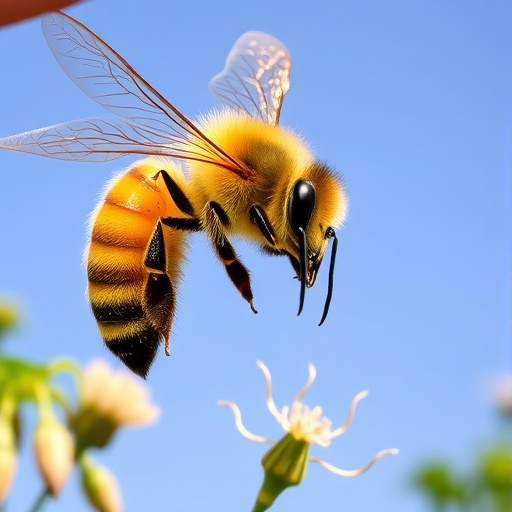UNIVERSITY PARK, Pa. — The intersection between natural ecosystems and modern technology offers a promising frontier for innovation, especially in the management of energy distribution systems. Central to this exploration is the groundbreaking work led by Wangda Zuo, a professor of architectural and mechanical engineering at Penn State. With a significant $1 million grant from the U.S. National Science Foundation, Zuo and his team aim to harness the organizational principles observed in honey bee colonies to rethink the structure and operation of electric grids.
Honey bees, renowned for their intricate social structures and collaborative resource management, provide a unique blueprint for achieving more resilient and efficient energy systems. Within a hive, bees exhibit remarkable coordination; they balance needs, share resources, and adapt to changing circumstances without reliance on a centralized authority. This decentralized model, exhibiting fluid dynamics of cooperation, offers valuable insights into how we might engineer a smarter, more flexible grid.
The research team, composed of experts from Penn State, the University of Colorado Boulder, the University of Vermont, and industry partners like Evoke Systems, is poised to investigate the parallels between bee behavior and the agility required in modern energy distribution. As the electricity landscape evolves with the proliferation of distributed energy resources—such as solar panels on rooftops and community microgrids—conventional hierarchical systems become less viable. Zuo argues for a shift towards a peer-to-peer interaction model that is not only inspired by bees but also necessary for future-proofing our electrical infrastructures.
This migration towards a decentralized framework is motivated by increasing unpredictability in energy demands and the varied energy contributions from individual households. Zuo explains, “The electric grid is becoming more dynamic and unpredictable, especially as more homes integrate solar arrays and energy storage solutions. By learning from how honey bees govern their communities, we can devise a grid that is equally capable of adapting to challenges, such as fluctuations in supply and demand.”
A fundamental shift in mindset is required to implement this honey bee-inspired approach. Instead of a rigid flow of information and energy from centralized entities, a network of interconnected devices—like electric vehicles, home batteries, and smart appliances—would engage in direct communication. Similar to how bees communicate and coordinate their feeding and honey storage, intelligent appliances will be capable of negotiating and sharing energy based on real-time needs and available resources.
The anticipated impact of these innovations extends beyond mere functionality. Zuo foresees a future where energy sharing becomes the norm within communities. This paradigm shift would empower individuals not just to consume energy but to participate actively in its distribution. Picture an interconnected neighborhood where energy flows seamlessly from your electric car to your home, or even to a neighbor in need during an outage. This network could drastically reduce costs, mitigate blackouts, and offer a solution to the rising burden of energy expenses that many families face today.
Moreover, Zuo underscores the ethical implications of designing such an energy-sharing system. “It is crucial that this new grid is equitable, making energy more accessible to disadvantaged communities who historically have faced disproportionate energy costs. Our aim is a modern grid that is not only smarter but also fairer,” he states.
The research efforts at Penn State focus particularly on how various building energy systems, such as heat pumps and water heaters, can function as proactive participants in this newly envisioned smart grid. These systems will not be passive consumers of energy but will dynamically contribute to the aggregate energy pool, transforming residential structures into intelligent agents within the energy network.
Collaborating with researchers from the University of Colorado Boulder and the University of Vermont, the interdisciplinary team incorporates principles from biology, computer science, and engineering. This convergence of disciplines allows for a more holistic approach to problem-solving, drawing upon diverse methodologies and insights to simulate and refine their concepts in advanced virtual environments before testing them in real-world scenarios.
In a continuously evolving energy landscape fraught with challenges brought on by climate change, aging infrastructure, and peak demand pressures, Zuo’s study represents a beacon of hope. If successful, this pioneering project could lead to a revolutionary overhaul of how energy is managed and distributed, ushering in an era of resilience where communities can withstand and rapidly recover from disruptions.
Ultimately, the synergy of biological behaviors and modern technology in Zuo’s work exemplifies how nature can inspire innovative solutions to our most pressing infrastructural challenges. By tapping into the sophisticated systems bees have honed over millions of years, researchers hope to engineer electric grids that are not only robust and efficient but also reflect a deeper understanding of cooperation and resource sharing.
The lessons gleaned from this research resonate far beyond the energy sector. They encourage us to examine all areas where natural systems provide insights into building resilience against the challenges of modern life. As we stand on the brink of transformative changes in energy distribution, Zuo’s research offers a glimpse of a future where intelligent collaboration governs not only our power supplies but also the sustainability of our communities.
Subject of Research: Honey bee-inspired approaches to electric grid management.
Article Title: Harnessing Nature: The Bee-Inspired Future of Our Electric Grid.
News Publication Date: [Date not provided]
Web References: [References not provided]
References: [References not provided]
Image Credits: Credit: College of Engineering/Penn State
Keywords
Applied Sciences, Energy Resilience, Distributed Energy Resources, Electric Grids, Bee-Inspired Design, Sustainable Technology.




